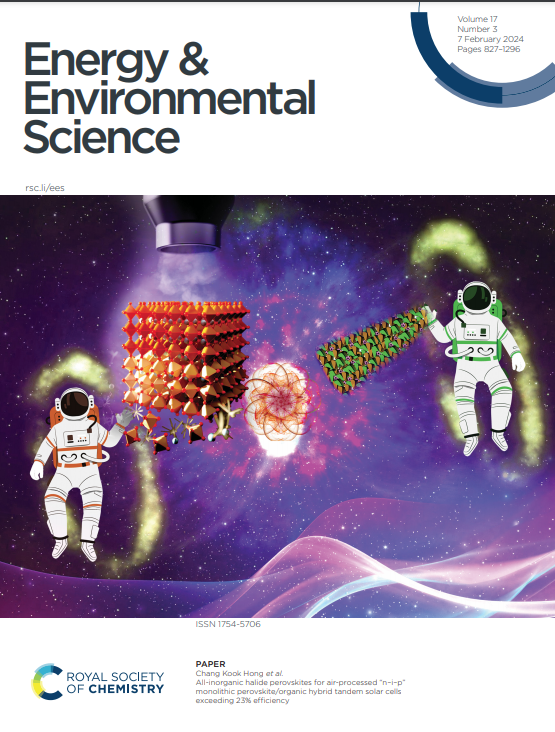Well-regulated Structures Featured Giant-molecule Acceptors Enable Long-term Stability and High-Performance Binary Organic Solar Cells
IF 32.4
1区 材料科学
Q1 CHEMISTRY, MULTIDISCIPLINARY
引用次数: 0
Abstract
The well-defined structures featured giant-molecule acceptors (GMAs) can exhibit unique properties of small-molecule acceptors and polymers simultaneously, and the consecutive innovations in materials design have enabled GMAs-based organic solar cells (OSCs) to possess outstanding devices power conversion efficiency (PCE) over 19% and extended long-term stability. Here, through systematically selecting the numbers and positions of selenium atom, π-spacer linking units and the outermost conjugate ring of central core of monomers, four novel GMAs are successfully synthesized, GMA-SSS, GMA-SSeS, GMA-SeSSe and GMA-SeSeSe. Surprisingly, PM6:GMA-SSeS-based OSC yields the highest PCE of 19.37% with remarkably open current voltage of 0.917 V with reduced voltage loss (ΔE3 = 0.246 eV), and excellent fill factor of 77.12%. Furthermore, when devices annealed at 100 °C, the PM6:GMA-SSeS and PM6:GMA-SSS-based OSCs exhibit remarkably extended t80% lifetimes of 5600 and 5250 h, respectively. Our work indicates that the selenium substituted regulation of GMAs structures in linking units and monomers is a valuable approach to obtain high-performance and long-term stability devices at the same time, shedding light on the further development of GMAs-based OSCs.以巨分子受体为特色的良好调节结构实现了二元有机太阳能电池的长期稳定性和高性能
巨分子受体(GMAs)具有定义明确的结构特点,可同时表现出小分子受体和聚合物的独特性质,材料设计的不断创新使基于 GMAs 的有机太阳能电池(OSCs)具有超过 19% 的出色器件功率转换效率(PCE)和更长的长期稳定性。本文通过系统选择硒原子、π-间隔连接单元和单体中心核最外层共轭环的数量和位置,成功合成了四种新型 GMA:GMA-SSS、GMA-SSeS、GMA-SeSSe 和 GMA-SeSeSe。令人惊讶的是,基于 PM6:GMA-SSeS 的 OSC 产生了 19.37% 的最高 PCE,开路电流电压高达 0.917 V,电压损耗降低(ΔE3 = 0.246 eV),填充因子高达 77.12%。此外,当器件在 100 °C 下退火时,基于 PM6:GMA-SSeS 和 PM6:GMA-SSS 的 OSCs 的 t80% 寿命显著延长,分别达到 5600 小时和 5250 小时。我们的工作表明,在连接单元和单体中对 GMAs 结构进行硒取代调节是同时获得高性能和长期稳定性器件的一种有价值的方法,为进一步开发基于 GMAs 的 OSCs 提供了启示。
本文章由计算机程序翻译,如有差异,请以英文原文为准。
求助全文
约1分钟内获得全文
求助全文
来源期刊

Energy & Environmental Science
化学-工程:化工
CiteScore
50.50
自引率
2.20%
发文量
349
审稿时长
2.2 months
期刊介绍:
Energy & Environmental Science, a peer-reviewed scientific journal, publishes original research and review articles covering interdisciplinary topics in the (bio)chemical and (bio)physical sciences, as well as chemical engineering disciplines. Published monthly by the Royal Society of Chemistry (RSC), a not-for-profit publisher, Energy & Environmental Science is recognized as a leading journal. It boasts an impressive impact factor of 8.500 as of 2009, ranking 8th among 140 journals in the category "Chemistry, Multidisciplinary," second among 71 journals in "Energy & Fuels," second among 128 journals in "Engineering, Chemical," and first among 181 scientific journals in "Environmental Sciences."
Energy & Environmental Science publishes various types of articles, including Research Papers (original scientific work), Review Articles, Perspectives, and Minireviews (feature review-type articles of broad interest), Communications (original scientific work of an urgent nature), Opinions (personal, often speculative viewpoints or hypotheses on current topics), and Analysis Articles (in-depth examination of energy-related issues).
 求助内容:
求助内容: 应助结果提醒方式:
应助结果提醒方式:


